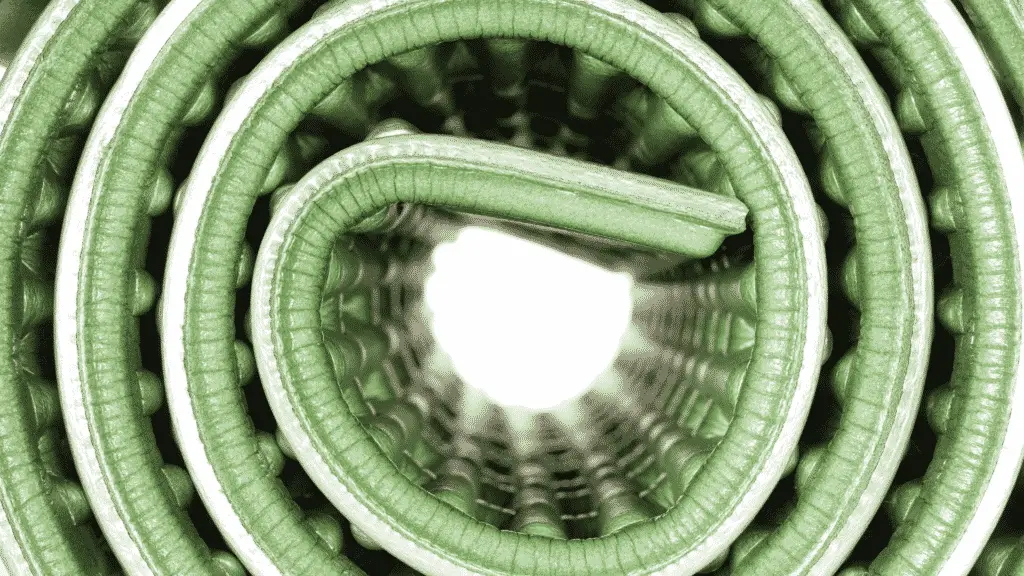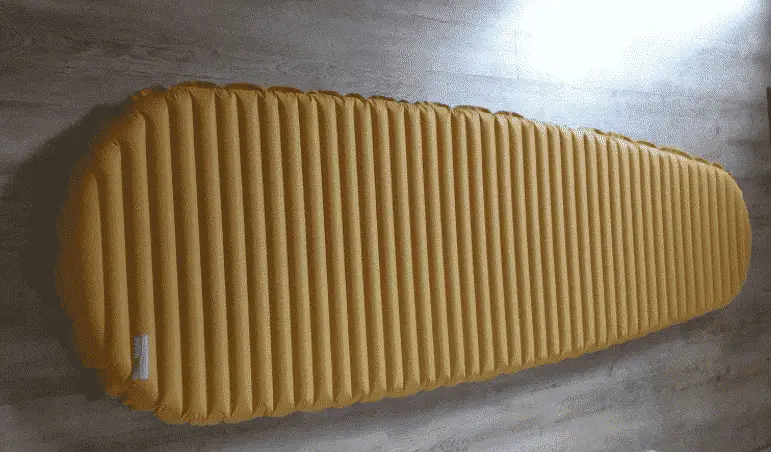A sleeping pads thickness is one of the most important factors when it comes to comfort. Increasing a sleeping pads thickness will almost always result in more comfort, but there is a tradeoff. Thicker pads are heavier and harder to pack. So where should you draw the line? How thick should a sleeping pad be?
The vast majority of self-inflating/inflatable sleeping pads are 2-2.5 inches thick. That’s thick enough to get your back off the ground while being lightweight and easy to pack. You may want to look into thinner or thicker sleeping pads if you’re car camping or trying to reduce pack weight.
How thick your sleeping pad should be is a matter of personal preference. Most people prefer a thicker pad, but there’s a point where it becomes too thick. In the rest of this post, I’ll explain different sleeping pad thicknesses and explain situations where it makes sense to use a thin sleeping pad.
How Thick Should A Sleeping Pad Be For Camping?
Sleeping pads have gotten thicker over the past couple of years. Most inflatable/self-inflating sleeping pads are 2.5″ thick, which is perfect for most people. That seems like the perfect size! Your butts up off the ground making it comfortable, and it’s still lightweight and easy to pack.
Some people like to choose thinner or thicker sleeping pads depending on their preferences. I usually use a 2″ thick pad (this one), because I wanted to reduce my trail weight with an X-Large wide/long pad. Thicker pads are more comfortable, but extra wide pads tend to be ridiculously heavy. My back is just up off the ground, but my butt touches a little bit (It’s still comfortable).
You can go with a thicker 3-5+ inch pad if you’re not worried about trail weight. Some of the thicker 4+ inch thick pads are basically like sleeping on a real air mattress. The only difference is you get the extra warmth of a high R-Value sleeping pad.
Backpacking Sleeping Pad Thickness

Backpacking sleeping pads need to be thinner than what you would use at a public campground or when you’re car camping. The pad needs to be lightweight and easy to pack. I recommend going with a 2-2.5 inch thick sleeping pad if you plan on backpacking. Here’s a list of the most common sleeping pad thicknesses.
- Less Than 1 Inch Thick: Most closed cell foam pads are less than 1 inch thick. It basically feels like your sleeping on the ground so they’re not very comfortable.
- 1.5 Inches Thick: This used to be the standard sleeping pad thickness when I grew up. Modern pads have increased in size, but a 1.5″ pad will do the job. I haven’t seen a 1.5″ thick sleeping pad recently. The thinnest inflatable/self-inflating pad I can think of is 1.75″.
- 2-2.5 Inches Thick: This is the new standard for self-inflating and inflatable sleeping pads. It seems to be the sweet spot for most backpackers. The pads thick enough to be warm and comfortable, but thin enough to reduce pack weight.
- 3 Inches Thick: A 3″ thick pad should be the absolute limit for backpacking. It’s still fairly packable, but it’s at least 1 pound or two heavier than a typical lightweight sleeping pad.
Camping Sleeping Pad Thickness
You can lean towards thicker sleeping pads if you don’t have to worry about carrying gear in your pack. I would probably go with a self-inflating pad for car camping. They’re a little bit heavier, but usually come in thicker sizes. Car camping sleeping pads usually fall in the following thicknesses.
- 2 Inches Thick: There are a few 1.75″ sleeping pads, but 2″ seems to be where most manufacturers draw the line. These pads won’t be like sleeping on a real mattress, but they’re plenty comfortable. I regularly use a 2″ thick Thermarest Basecamp Self-Inflating pad and it meets my needs. It was one of the only lightweight extra wide pads that I could find at 77″x30″.
- 2.5-3 Inches Thick: This is where most people go. The pads are thick enough to provide lots of comfort and still small/light enough to load in your pack. A 2.5″ thick pad will be cheaper, but 3″ thick is really comfortable! Your butt will be at least 1 inch off the ground so there’s plenty of cushion.
- 3.5-4+ Inches Thick: Once you get into the 3.5-4+ inch range you’re basically dealing with an inflatable air mattress. The only difference is there’s additional insulation to increase the R-Value (more warmth).
Thin Foam Sleeping Pads Won’t Be Very Comfortable

I don’t get how anybody could use a foam sleeping pad on its own. They’re usually less than 1 inch thick and ridiculously hard. You won’t be as cold, but it’s basically like sleeping on the ground!
Most people use foam pads alongside their inflatable/self-inflating pad. It increases cushioning a little bit, protects inflatable pads from punctures, and doubles up the R-Value of your sleeping pad. You can combine R-Values when you use two sleeping pads together.
Thick Sleeping Pads Offer More Back Support
A 2″ thick inflatable/self-inflating pad should be the bare minimum when it comes to back support and comfort. It’s thicker than the vast majority of sleeping pads that came out in the 90s and early 2000s, but thin enough to be easy to pack.
My butt barely touches the ground with a 2″ sleeping pads, but I’m a pretty big guy. Don’t get me wrong! A 2″ pad is plenty comfortable and I like the fact that 2″ pad cuts some weight out of my pack. Some people prefer a thicker pad, but it’s rarely necessary.
I think 2.5″+ thick sleeping pads are perfect for most people. They get your back/butt up off the ground and they’re still light and small enough to carry on the trail. A 3″ pad will also work for backpacking, but that’s pushing the limit.
Don’t Overinflate A Thick Sleeping Pad!
Be careful when you use overly thick sleeping pads. Overinflating thick pads leads to a weird bouncy feeling. You feel like your laying down on a balancing beam struggling to keep your body still. Try to reduce the amount of air in your pad so your back can sink down into the pad.
Filling up a sleeping pad is easy. Start by overinflating the sleeping pad and then slowly let out air. Keep letting out air until your back is slightly above the ground. This increases the stability in the pad and helps prevent rolling off in the middle of the night.
Thick Sleeping Pads Will Are Warmer
Increasing sleeping pad thickness almost always increases the R-Value. A 3+ inch thick sleeping pad will almost always be rated for winter use (5+ R-Value). There are 2-2.5 inch thick sleeping pads that are rated for winter use, but they’re not common.
The Thermarest Basecamp Sleeping Pad is an affordable 6 R-Value pad that’s only 2 inches thick. I actually own the X-Large 77″x30″ version and it’s surprisingly comfortable. It would be nice if the pad was a little bit thicker, but I bought it because it’s lighter than every other 30″ wide pad I looked at.




